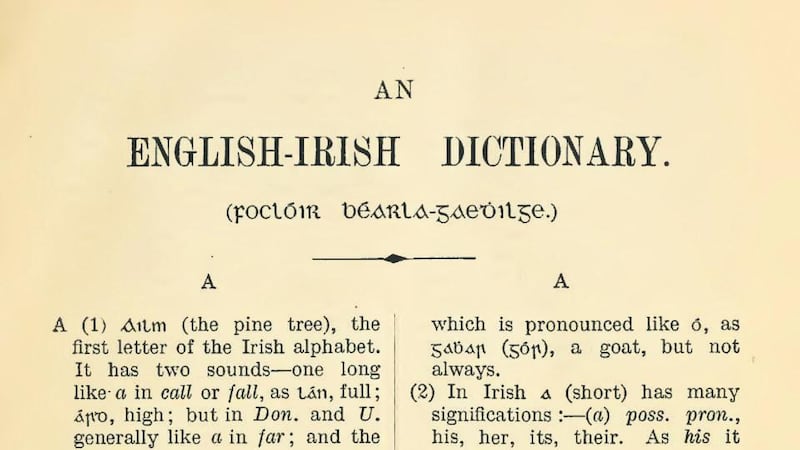The letter, lost for 63 years, eventually found its way to Limerick in 1971. Posted from Canada in 1908, it encouraged the production of a second, more robust volume of an English-Irish dictionary. Its intended recipient had died in 1915, but he had already heeded the advice.
The letter was addressed to Timothy O'Neill Lane, a teacher, clerk, lexicographer and Times of London journalist who produced the first English-Irish dictionary of the 20th century.
O’Neill Lane’s enormous contribution and dedication to the Irish language have remained relatively unknown. Next month a plaque will be unveiled to mark the centenary of his death in his native Templeglantine, Co Limerick. Across the county border a headstone will be erected to mark his final resting place, in Brosna, in Kerry.


“The Irish language would have been strong in the Templeglantine area,” says Tadhg O’Maolcatha, a local historian who has been researching O’Neill Lane since the 1970s.
“A census carried out in 1851 showed that 60 per cent of the adult population spoke Irish,” he says. “Under British rule no Irish was taught in schools, but O’Neill Lane was raised bilingually and would have had a good grasp of the language in his formative years.”
O’Neill Lane was born in 1852 to a prosperous farmer. He taught at his local school for seven years before applying for the civil service. He passed the written examinations but failed the medical test. O’Neill Lane had been born with a deformed foot, which gave him a life-long limp. He wore specially made shoes and never travelled without his walking stick.
He persevered with a career change, however, and was appointed as a clerk to the Incorporated Law Society in London. But it wasn't long before he moved again, when a relative secured him a job as Paris correspondent for the Times.
It was in Paris in the 1880s that he began work on his dictionary. Dictionaries had been produced in the 18th and 19th centuries, but O’Neill Lane found them to be lacking. His aim was to produce something that would better inform students of Irish. By the time he finally finished, in 1904, he had spent more than £2,500 – more than €325,000 today – to complete it.
O’Neill Lane spent five years travelling around Ireland. He made the most of his time and wrote a series of travel books while visiting Gaeltacht areas, where he collected words and phrases from locals. Words thought to be obsolete in Munster he found alive and well in other parts of the country, so he documented regional variations of Irish words and phrases.
The support for the dictionary was substantial. O’Neill Lane received a grant of £250 – about €32,500 today – from the British government to produce the book and had more than 650 advance subscriptions. Clergy made up the bulk of subscribers, but people from all over Ireland, the United States, Canada and Australia also gave their support.
As soon as his 581-page work was published, however, O’Neill Lane expressed dissatisfaction with it. He had at this stage given up his journalism career and partly blamed his Paris commitments for shortcomings in the first edition.
“When he realised that the first one was inadequate he started work straight away on the second,” says O’Maolcatha. “He had included in his first edition an appeal for corrections and omissions, with a prize of £25 for the person who provided him with the best information.”
It was because of this appeal that a C Hylton of Ontario wrote the letter that arrived six decades late. “You will be mistaken if you don’t reprint such a magnificent work,” the Canadian wrote.
O’Neill Lane asked that corrections be sent to Tournafulla, a parish a few kilometres from Templeglantine, where he later lived with his cousins. O’Neill Lane had married an Englishwoman, and they had a son and a daughter, but neither wife nor daughter ever set foot in Ireland. (His son spent time at the school in Tournafulla and later edited an English-language newspaper in Shanghai.)
Many corrections
“The second edition was a magnificent publication,” says O’Maolcatha. “He gave much longer explanations, and there are a lot more words, so we assume that many omissions were pointed out to him. He made notes on half a million slips of paper, and his final manuscript ran to 5,000 quarto pages.
“I’m sure that he would have travelled around for the second edition, but he was also in heavy correspondence with many scholars from around the country who also helped with the editing process.”
Published in 1915, his revised edition was one and a half times the size of the first. It was as useful as a standalone English dictionary as it was as an Irish translator.
It made a vast amount of material available at a time when the Gaelic League was enjoying huge popularity. Lane's English-Irish Dictionary was largely bought by scholars and clergy educating young people in their native tongue.
Although he received many subscriptions for the second edition, producing it left O’Neill Lane virtually penniless. The day before he passed away a copy of the dictionary arrived by train at his local station in Limerick. He laid his hands on it on his deathbed and died on May 8th, 1915.










